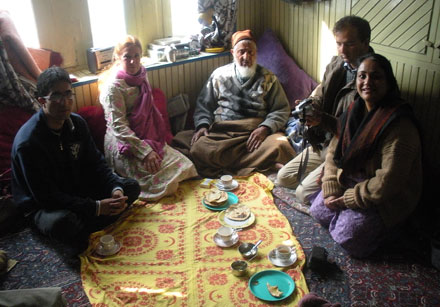Shrines of mystic saints and Sufis in Kashmir continue to be common collective spaces for both Hindus and Muslims. Many renowned Kashmiri Muslim poets have nurtured the philosophy of Kashmiri Shaivism in their poems. This syncretic tradition is what all Kashmiris upheld in their daily lives. To me, growing up in Kashmir, the ‘soul’ of the region was always embedded in the traditions of dialogue and co-existence. This culture, and the daily practices of Kashmiris, was what I would define as peace.
But in today’s Kashmir all this seems vague, fading away. There also exists the reality of an extremist agenda and propagation of an Islam which is alien to the indigenous cultural form that the Kashmiri Hindus and Muslims feel safe and secure with. In the new ‘Muslim Kashmir’, is there still scope for recovering the heterogeneous character of Kashmir? Can mechanisms be put in place to engage with the diversity in a constructive and progressive way? If the legacy of coexistence is to be saved, urgent steps need to be taken by both the state and its people, and especially by peace practitioners and peacemakers.
Religious leaders and institutions have often helped in transforming conflicts, either exacerbating or diffusing them. They have made choices to either use religion for dividing people, or for creating peace in their communities and regions. Jammu, Kashmir and Ladakh are no exceptions in this regard. On a recent visit to Jammu & Kashmir, Tom Gillhespy of Peace Direct suggested to me that it will be a good idea to engage with moderate religious leaders and explore possibilities for social change, and the opportunity to do so came very soon thereafter.
The Global Peace Initiative of Women is hoping to initiate a dialogue between Sufi practitioner-scholars and those of the Shaivaite (Hindu) tradition in Kashmir. These two spiritual philosophies have different approaches to understanding union with God, but both speak about universal brotherhood, inclusiveness and dialogue as the hallmark of human relationships.

As part of this dialogue, I went to meet Mian Bashir, a Naqashbandi spiritual leader, in his home in Wangat Valley, Kangan, around one and half hour drive from capital city Srinagar in Kashmir. Mian Bashir is known to his followers as ‘Sajjada Nasheen’, who travel from and Jammu & Kashmir, Pakistan and beyond to see him. “My door never closes before eleven in the night”, he says with a smile. As we drove up the small hill where he lives, we saw scores of people trekking up to see him.
People sitting in the room with us told stories of the miracles associated with Mian Bashir. How once he blessed the villagers with water and at other times spoke about his concern and the actions he takes for the welfare of the marginalized. Mian Bashir, himself narrated many stories in which were hidden deeper meanings of inter-dependence, cultural values and spiritual revelations. “We do not reach out to know the other”, he said. He added with pained expressions that while India is a spiritual land where many paigambar (prophets) rested, aman (peace) was killed here when the country was partitioned and Mahatma Gandhi was killed. “And I hoped that Pakistan would prosper and rise, but sadly that has not happened”, he said.
It was heartening to see continuing openness to dialogue amongst religious leaders. The openness to dialogue of Mian Bashir is mirrored for example by the Shaivite (Hindu) scholar Dr. Moti Lal Pandit (currently based in New Delhi) who stated “there is always hope. While one has to be cautious, one should also keep ones mind open. I am willing to listen”. The word of Sufis and Shaivaites whom we met have given me hope and encouraged me.
This dialogue will continue over the coming months, and I will provide updates through this blog. It promises to be an enriching process.
Posted by Ashima Kaul, 2 December 2009








